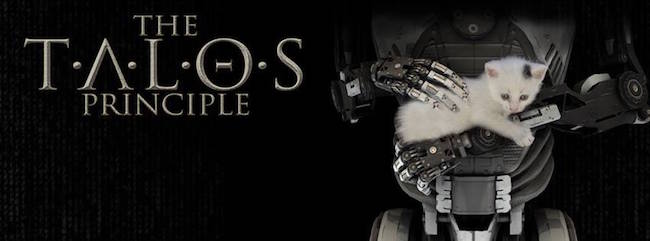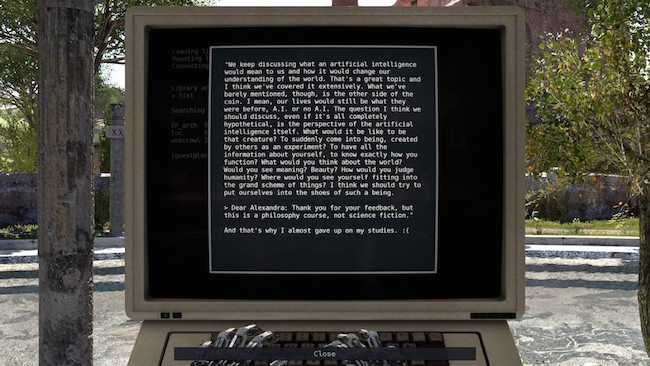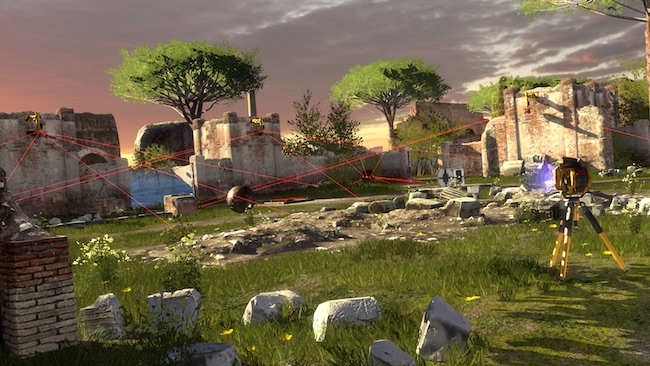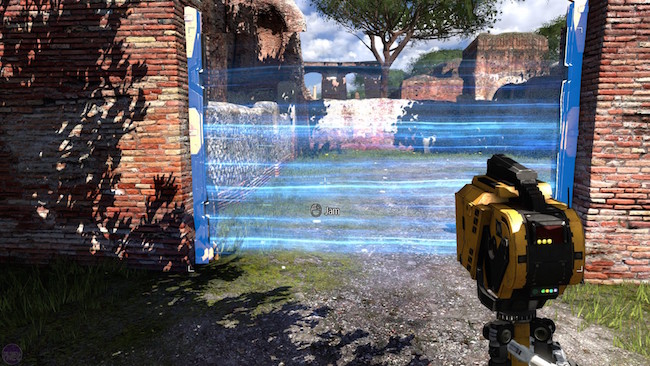
It’s been quite awhile since I last invested myself into a puzzle game, but from what I heard about The Talos Principle before launch, it was seemingly going to be a decent experience. Admittedly, I had some initial reservations that the game would be a lot like Portal; minus the unique charm and personality. However, within the first minute of playing, my preconceived notions were quickly proven wrong; with the game really coming into its own. With Portal being held in such high regard by me as “the perfect game,” I still couldn’t help but draw comparisons between the two titles, but the genius behind the design of the Talos Principle has made this game a distinctive experience that stands on its own merits as an excellent first-person puzzler.
The Talos Principle contains layer upon layer of deep narrative that left me thinking almost as much as the puzzles did. The main story begins as soon as you are spawned into the world, with an ominous voice called Elohim (the Hebrew word for God) directing you to collect Tetris-shaped objects called sigils; which reside at the end of each puzzle. Elohim subsequently promises eternal life once all of the sigils have been collected, but upon discovering a giant tower after completing the primary levels, things become a little more convoluted. Elohim, despite encouraging me to roam the world as I wished, forbade me from climbing this tower. With the obvious religious parallels, each building, which houses seven chambers that hold various sigils, represents a religious culture, and the terminals found in each chamber provide insight into the cultures via stories told.

As well as the aforementioned stories, a resident AI called Milton resides in the terminals. With an obvious conception based on GLaDOS, this AI adds to the narrative by utilizing the overarching story to use the topic of free will to challenge the player to climb the tower. Launching from this, Milton goes on to discuss what defines a human from other forms of life, and, in turn, if a robot held such characteristics would they, in fact, be human. Whilst exploring this issue, the conversations with Milton explore thought-provoking, and, at times, confrontational ideas; touching on themes such as morality, personality, and consciousness. When asked to define such concepts properly by an AI program, I was left with a lot to think about after walking away from the game. One particular conversation with Milton revealed a lot of confronting values that I thought were admirable, when Milton discussed whether happiness in humanity should be maximized or equalised.
Aside from conversations with Milton and the ancient stories you’ll uncover, these terminals also house the lore on topics such as how the game world came to be, as well as identifying certain people who were involved in setting up the world. One particular person, who has left audio logs lying around the level, particularly in the tower (which houses a “horrible truth”), reveals some genuinely haunting insight into the origins of the player. Although, with that being said, a lot of the lore is presented through rather large chunks of text. Despite being a puzzle game, I found the pacing of the game pretty quick. This pacing meant that having to stop and read a wall of text when I was eager to get to the next set of puzzles was a bit of an inconvenience. As I rushed through the readings trying just to get the gist of the content, I felt the further use of audio logs would have been a much more effective use of delivery.

With that being said, as brilliant as the narrative was, I still felt it was disconnected to the gameplay. Neither gameplay nor story gave each other context, so, despite both being exceptional, they both stood alone. Luckily neither story nor gameplay affected each other negatively, the two just didn’t seem to intersect throughout the game.
When playing puzzle games, the most important quality to me is if the puzzles make the player feel clever upon solving them. The Talos Principle executes this in a fantastic manner, with most of the puzzles not only relying on the players puzzle solving skills, but sometimes more so on the player’s own creativity.
Initially, I was introduced to the most basic mechanic, a jammer that can deactivate temporary barriers and disable self-destructing robots; this allowed me to navigate through the first couple of stages. I was then eased into the world and became fairly comfortable with the game before the complexity of puzzles increased. Admittedly, the learning curve was fairly easy at the beginning; however, the simplicity of the first puzzles did a good job to set the pace of the game. Once the puzzles became more complex, new mechanics were subsequently unlocked as I collected sigils. These mechanics ranged from movable boxes, fans that can levitate objects, and, my favourite: a recording device that records a temporary clone of yourself that you can work with to solve puzzles. With these mechanics at my disposal, I was encouraged, and sometimes demanded to try the craziest and most creative action in order to acquire the sigil. Both pragmatic and lateral thinking was necessary in order to progress through the game.

As mentioned, the pacing of the game was fairly quick, which means the puzzles are fairly small and did not take more than a couple of minutes to solve. Most of the game was spent looking at the puzzles and all of the assets at my disposal and concocting ideas of how to combine these assets to unlock barriers and navigate the level. For me, these quick puzzles easily sucked me right into the game, and that line “just one more puzzle” often was repeated throughout my time with the game. With the total hours of a play through reaching around 14 hours, and the puzzles being so quick to complete, there were around 120 puzzles to complete. Despite the numerous amount of puzzles though, it rarely ever felt like a chore going through room after room to solve them.
With quick pacing and so many creative puzzle designs, it was a little disappointing when, at later stages, a couple of puzzles required a little amount of creative thinking and were merely waiting games. This meant standing on a certain spot and waiting for the right time to run through a bunch of self-destructing robots. Personally, I found this method of navigating the level and solving puzzles to be out of place when compared how I went about collecting other sigils. When I failed to complete these particular puzzles by rushing through them, retrying them felt tedious and annoying. Trying to find a solution is a lot more enjoyable for this sort of game, as opposed to having the path laid out in front of you with the challenge being in the execution.

Furthermore, in later stages, I felt a couple of puzzles were a little too forgiving. Whilst solving them, I noticed a couple mistakes I made, but the puzzle was still able to get solved. Given how quick it would generally take to complete a stage, the design could have afforded to make the puzzles a little harsher in the later stages. On the positive side, however, the controls are set up for basic movement and interaction functions. The various mechanics were always represented clearly and would let me know precisely what each new mechanic did. The controls were simple and responded fairly well too. Although, the camera was fairly rigid when playing with a controller, and, for me at least, playing for extended periods did make me feel nauseous.
From the first time I saw The Talos Principle, I was immediately taken with how visually stunning the game was. Keeping the assets slightly stylised, the game was very pretty and made the hours spent staring at the world, as well as trying to solve how to navigate each room a pleasure. Each chamber was vastly different in theme from the previous, but they all tied together really well and looked equally as stunning, this especially showed when I chose to climb the tower during the end game. Apart from the slightly awkward shadow texture rendering, the game does well to have me feeling content with just looking around and seeing how aesthetically appealing this world is.
The music is also paired excellently with the visuals. An ominous deep soundtrack reinforces the majestic world and heavy themes explored in the game. The presentation definitely made me feel that I was a part of something much greater than just solving puzzles.
 Interesting and thought provoking narrative
Interesting and thought provoking narrative
 Puzzle design encourages player creativity
Puzzle design encourages player creativity
 World is very aesthetically pleasing
World is very aesthetically pleasing
 Excellent pacing, with very minimal tedium
Excellent pacing, with very minimal tedium
 Disconnect between narrative and gameplay
Disconnect between narrative and gameplay
 A few later puzzle-designs don’t fit the tone
A few later puzzle-designs don’t fit the tone
With all the unavoidable comparisons to Portal, I definitely walked away feeling that this title is almost on equal footing. The Talos Principle is everything that a puzzle game should be, and then offers a little bit more. Despite the fantastic narrative and gameplay not being interwoven, the pacing, level design and mechanics all harmonised together really well, and made me want to solve puzzle after puzzle for hours on end just to stay in this magnificent world.











